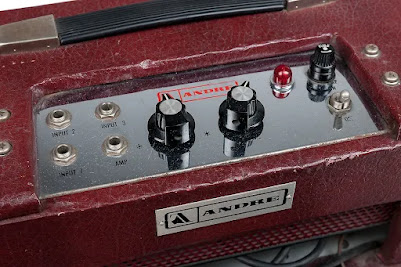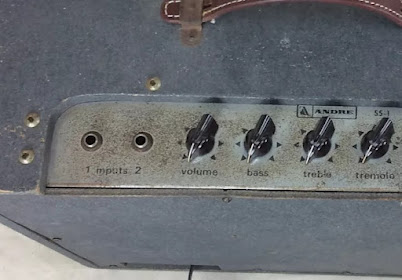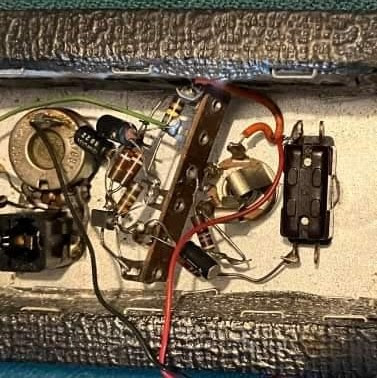One of the most ubiquitous pedals in the vintage effects world has to be what collectors have dubbed, the "East Coast Fuzz". As of now 11 different OEM brandings have emerged, with the Manny's Fuzz, the Orpheum Fuzz, and the Clark Fuzz Tone being the most prevalent. But interestingly, and even though the pedal dates from the late 60s, we are still unaware of who actually built them!So with this post, we are going to try and lay out everything that I've been able to find so far. I'm definitely not the first person to go here, and in many ways I'm standing on the shoulders of the vintage pedal-researching giants that came before me. So my main goal is to just have a singular place where all of this info can live and can be gone through by you, in hopes that we can uncover something new...
A common practice in the 1960s, whether it was amplifiers, guitars, or organs, was to establish your musical instrument company by paying a third-party manufacturer to build the gear and slap your logo on the front. Often you could walk into multiple shops selling the same exact product, with the only difference being the branding. And while this is a well known part of amplifier and guitar history, when it comes to effects we tend towards the idea that each brand had its own factory building the pedals in-house.
But Japan is the perfect example of an antithesis to this mentality. The majority of Japanese effects built from the 1960s - 1980s were made by just a handful of manufacturing plants; with brands like
Locobox,
Ibanez,
Companion,
Coron, and many more. But in the U.S. this appears to be the exception rather than the rule.
And instead of a completely unknown-to-the-public manufacturer, what we did see over here were brands like
Electro Harmonix, who in addition to having their own pedals, also ran an OEM program with alternate brandings like
Guild,
Lyle, and
Electra.
Why this all matters to the East Coast Fuzz story, is that part of the mystery lies in the fact that we don't know if any of these brandings are the true original, or if they were all built by an unknown third party manufacturer (not unlike the infamous
AUL Fuzz).
With all that being said, let's dive into what we do know...
So there is some debate on what year these were first built. But if we go off the fact that they were essentially derivations of the earliest Fuzzrites, then we know that they couldn't have come before 1966. I say that because I have seen some units that have pot codes dating to the early 60s, which has led to confusion in the past.
So the accepted range of years for the East Coast Fuzz inception is 1966-1968. And it is also accepted that they were built somewhere in the New York/New Jersey area, based on the location of the 11 OEM brands; Manny's Music of New York, Gracin's Music of New York, Clark Music Industries, of New Jersey, Mica-Tone of New York, etc.
When we look inside the East Coast Fuzzes what we do find is a mixture of parts common to that era and location. Other brands such as
Applied Audio (New Jersey),
UMI (New York),
Universal Amplifier Corp (New York) were all active in the late 60s and used a very similar mixture of components in their own pedals. But this most likely points to each manufacturer using the same distributors/shops for these components as opposed to the idea that one of them is responsible for building the East Coast Fuzzes.
So instead of focusing all of our attention on the types of capacitors used or which color wiring they chose, we're going to go a bit more, macro...
Until last week I did not know that this existed. What you see above is a Manny's branded reverb tank from the late 60s. There are a few key similarities with the Manny's Fuzz that immediately pop out:
1. The Manny's logo (and address) are identical in both.
2. The knobs used in this reverb unit are also found on many of the East Coast Fuzzes.
3. The little * astericks * printed next to the Volume and Reverb controls are very odd, and are also seen on the Orpheum Fuzzes.
4. The acrylic logo plate on the front of the unit seems very similar to the acrylic plate you see on the top of the East Coast Fuzzes.
So I dug a bit more, and was able to find 5 total OEM reverb units that also have corresponding East Coast Fuzz builds! These include Halifax, Mica-Tone, Gracin's, and Andre.
But the one that really stood out was the Andre reverb. Not only was it in a deep red color, but the knobs were different, the logo plate was different, and the handle was different. And interestingly, we also see similar odd differences in the
Andre Fuzzier (their version of the East Coast Fuzz).
Soooooo, Andre who?
Gene Andre was a young Russian refugee with a deep interest in electronics who found a home in New Jersey, just outside of NYC. In 1964 he got a job working for a little local amplifier company you may have heard of before, called
Ampeg, where he became known for being the best troubleshooter in the business.
In 1966 Ampeg's top engineer Jess Oliver left the company and began his own amplifier brand,
Oliver Sound Inc. With the promise of true design work, Gene Andre decided to moonlight with this new venture while still working his regular troubleshooting shifts at Ampeg. This lasted nearly three years, until 1969 when he finally decided to open his own repair/custom shop called Andre Audio-Tronics, Inc.
According to this trademark filing, in addition to the Fuzzier and the Reverberation units he also built amps, a phase shifter, mixers, and at least one additional effect, a tremolo. Fans of Ampeg will quickly recognize the similarity in many of his builds to Ampeg units, and they will also point out that Andre went as far as to buy old parts-stock directly from Ampeg to use in his builds.
The most glaring example of this is his tremolo pedal, built right into the enclosure of an
Ampeg Scrambler:
As hilarious as that is, I can't help notice the similarities between the Tremolo and the Fuzzier, and even the Reverb. They all appear to be made by the same builder. Which begs the question; was Andre responsible for the East Coast Fuzzes?
When we look at things like the foam-taped circuit, the black "goop" found on the tremolo PCB that you also see on some East Coast Fuzz units, the rubber grip tread on the base of the pedals, and the same odd "94047" transistors you see in the
Gracin's Fubar units, it becomes hard to deny that they all probably share a common origin.
That all said, there is a perfectly logical explanation that doesn't end in Gene Andre as the builder of the East Coast Fuzzes. It is definitely a possibility that they simply hired the same manufacturing plant who was already building the fuzz pedals to also build the tremolo and the reverb tank.
But there sure are a lot of similarities between all of the Andre products and the East Coast Fuzzes that are hard to ignore. And while these similarities make a great case, it's the unique differences that really make Andre noteworthy.
Those asterisks though, where have I seen them before??? 🤔
A connection I was not expecting to make with the East Coast Fuzzes, was one I stumbled upon while looking into the reverb tanks.
I found a listing for the Manny's branded version that stated it was made by Ampeg. Yes, that Ampeg! And while I initially brushed this off as some hyperbolic sales tactic, I decided to look into it and see what I could find, just in case.
And luckily I did because the first thing I noticed was those damn asterisks! It looks like they were fairly common on Ampeg control panels from the 60s, used to indicate that a particular pot had a "special" setting that was engaged with the final turn/click of that knob.
So while they are definitely a cool similarity, it is important to note that Ampeg's use was different from the asterisks you see on the Orpheum Fuzzes, and they're also printed in different directions from each other.
Another common bond I found between Ampeg, the reverb units, and the East Coast Fuzzes were the knobs. Many of the 60s Ampeg models share knobs with at least one of the fuzzes. *see the amp above.
And while it is true that many unrelated brands used similar knobs in the 60s, the two examples below seem to only exist on the East Coast Fuzzes and various Ampeg models.
Another very specific detail that I noticed between the Manny's reverb units, the Andre Amps, and Ampeg was the weird screws they all used.
Known as "clutch head" screws, these are typically hallmarks of Ampeg amps from this time period. So to also find them on potentially related OEM products is extremely interesting!
One final, and subtle similarity is something you'll specifically see between Ampeg and Andre. At some point in 1969 Ampeg started to put knob placement markers around each pot, using 7 small triangles that extended from a circular line.
And seemingly at the same time Andre used and almost identical marking system, with the 7 triangles around the knob, sans a circular line. You can find these on both their amps and the Andre Fuzzier pedal.
So does all this mean that AMPEG!!! made the East Coast Fuzzes?
Well, there is one final candidate with an interesting bit of compelling evidence...
In addition to Orpheum and Manny's, the next most common East Coast Fuzz branding was a small speaker cabinet builder from New Jersey, called Clark Music Industries.
Clark was owned and run by Hillard Gretchis, who was a WWII Army veteran, and later a Chief Engineer of the Merchant Marines. Gretchis also owned a lumber company called (you guessed it!)
Clark Lumber.
In researching Clark Music Industries I was lead to this
2017 blog post from Rich Excellente. You may not know him by name, but he is the reason that
Snarling Dogs effects exist! He not only helped the brand pivot from guitar strings to pedals, but he also designed many of them.
And while that is a fun fact, the curveball I did not expect was when Excellente said that he worked for Clark right out of high school, and his main job was wiring speaker columns and fuzz boxes! Which would imply one of two things; either Clark made another fuzz pedal we have yet to see, or he was talking about building the East Coast Fuzzes.
But the revelations don't stop there, because in the comments section of a now-deleted Youtube video, Excellente went on to describe the East Coast Fuzzes perfectly, and stated that for a fact, Clark was the builder.
He also said that the circuit was based on a combination of the Fuzzrite and the Maestro Fuzz Tone, which is pretty specific knowledge. *note that it's very much a Fuzzrite, with some value changes.
And if this wasn't enough, he dropped one more crazy piece of info in that Youtube comment, stating that during the 60's Clark supposedly built the amp cabs for Ampeg! *who was located just one town over in Linden, NJ.
I have yet to find any solid facts or confirmation to back up this claim, but I will say that it does make sense. The fact that Gretchis not only owned a speaker cabinet company, but also a lumber company, that were both located less that 5 miles from Ampeg, is a very compelling narrative.
But the case for Clark does not end there, because the "Clark" labeled fuzzes all had something that the rest of the units did not. And that was in place of grip-tread on the bottom plate, they had an instructions sticker.
And while that fact alone doesn't suggest much, what this sticker says towards the bottom definitely does...
"Manufactured and Distributed by Clark Music Industries"
Alone, that little phrase doesn't definitively make the case. As we have seen other OEM brands claim to be the "manufacturer" of their pedals when we know for a fact that they were not.
But in this scenario, with a somewhat detailed background story from an ex-employee, the claim holds significantly more weight. Especially when we consider the other pieces of this puzzle.
But there was one thing I did notice when reading back through Rich Excellente's blog post:
"After high school, I landed a job with Clark Electronics in Clark N.J. assembling P.A. column speakers and wiring fuzz boxes. It was a only three man operation. The Clark fuzz sounded raunchy..."
If you look, he says that he got a job "wiring fuzz boxes", which could imply a few things; A: that by the time he got there they were already in production. B: he never says that he designed the circuit (which if he was just telling stories to conflate his own past, he almost certainly would take credit for the fuzz itself), and C: the possibility that Clark was just responsible for manufacturing the enclosures, while a mysterious 3rd party was actually building the circuits (which meant that all Clark had to do was wire up the populated PCB's to their enclosures).
These are all guesses of course, but ones that I hope can lead to some good questions, and even better answers in the future.
Now if you know these pedals well, you will probably make the point that the Clark labeled fuzzes typically utilize, what we believe to be, the later silicon version of the circuit. And also that the enclosure itself was larger than the Manny's and Orpheum versions.
One thing that has made it difficult to pin down the original builder, is that over the whole production period there seems to be at least 3 separate enclosures that were used, and a countless variation of parts and components.
Things like toggle switches, transistors, capacitors, and pots vary from pedal to pedal. And while there does seem to be some amount of consistency to these inconsistencies, it has made it hard to really say which fuzz came out when.
What we tend to believe is the final version of the East Coast Fuzz is found in the 3-knob Gracin's,
AAT, and Andre Fuzzier pedals. They all have a unique enclosure that's tall like the Clark, puts the knobs in a triangle formation, and at least two of them have an additional slant below the jacks.
But even within these oddballs the Andre stands alone.
And while the evidence for Clark is very solid, I can't help but go back to Andre. Why were they the only ones to have a red-colored reverb unit? Why were they they only ones to use those weird knobs? Why were they they only ones to use the triangle knob configuration in a upside-down pattern?
We do see forms of "customization" with OEM manufactures, but rarely to the level we see with the Andre Fuzziers and reverb tanks. And what about that tremolo that's clearly built inside of an Ampeg Scrambler enclosure??? There's also an Andre microphone mixer that appears to have the same build style as the fuzzes, with a metal faceplate and wooden sides covered in tolex:
I think we are super close, as the truth probably lies somewhere in the connection between Andre, Ampeg and Clark.
And while I would love to lay out my working theory, I'm actually much more interested in hearing how YOU interpret all of the info in this article. Because while I have my ideas, what I do know, is that there is still a lot I do not know...
So that was supposed to be the end of this post, but as I was finishing up a friend of the blog reached out with photos of his original Orpheum Fuzz, and inside was an amazing surprise...
Do you see it?
At first glance you're probably thinking "What am I looking at? It just looks like the inside of any regular germanium Orpheum Fuzz."
But if you look again, you will notice that the name "Gene" is printed on one of the wooden sides. And if you're thinking "so what?" and this is probably just someone's way of labeling their own pedal; let me ask you
Why would they do that?
Who puts their name on the INSIDE of a pedal to make sure it doesn't get stolen or confused with another band member's?
But ok, if it was put there during production, what does it mean? Who is Gene?
Is it possible that it was put there by... Gene Andre, of Andre Audio-tronics!
And yes, there is no way of knowing for sure, until maybe we see some other Orpheum Fuzzes with that labeling (mine just has the number "17" written on the inside). But with everything else we do know, it would be an insane coincidence.
So what do you think?
Please leave a comment below or reach out to me directly
via
Email or
Instagram if you have any additional info that could help solve this 50+ year fuzz mystery.
This was definitely a long one! So thank you for reading the whole way through,
-ed




















































